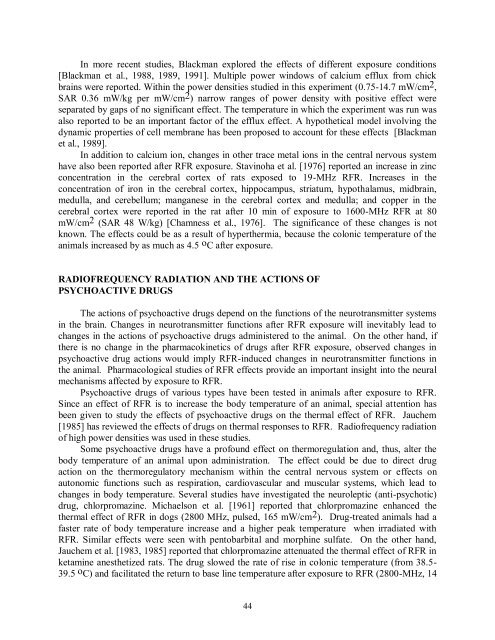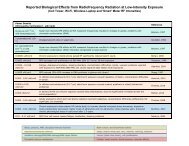Evidence for Effects on Neurology and Behavior - BioInitiative Report
Evidence for Effects on Neurology and Behavior - BioInitiative Report
Evidence for Effects on Neurology and Behavior - BioInitiative Report
You also want an ePaper? Increase the reach of your titles
YUMPU automatically turns print PDFs into web optimized ePapers that Google loves.
In more recent studies, Blackman explored the effects of different exposure c<strong>on</strong>diti<strong>on</strong>s<br />
[Blackman et al., 1988, 1989, 1991]. Multiple power windows of calcium efflux from chick<br />
brains were reported. Within the power densities studied in this experiment (0.75-14.7 mW/cm 2 ,<br />
SAR 0.36 mW/kg per mW/cm 2 ) narrow ranges of power density with positive effect were<br />
separated by gaps of no significant effect. The temperature in which the experiment was run was<br />
also reported to be an important factor of the efflux effect. A hypothetical model involving the<br />
dynamic properties of cell membrane has been proposed to account <str<strong>on</strong>g>for</str<strong>on</strong>g> these effects [Blackman<br />
et al., 1989].<br />
In additi<strong>on</strong> to calcium i<strong>on</strong>, changes in other trace metal i<strong>on</strong>s in the central nervous system<br />
have also been reported after RFR exposure. Stavinoha et al. [1976] reported an increase in zinc<br />
c<strong>on</strong>centrati<strong>on</strong> in the cerebral cortex of rats exposed to 19-MHz RFR. Increases in the<br />
c<strong>on</strong>centrati<strong>on</strong> of ir<strong>on</strong> in the cerebral cortex, hippocampus, striatum, hypothalamus, midbrain,<br />
medulla, <strong>and</strong> cerebellum; manganese in the cerebral cortex <strong>and</strong> medulla; <strong>and</strong> copper in the<br />
cerebral cortex were reported in the rat after 10 min of exposure to 1600-MHz RFR at 80<br />
mW/cm 2 (SAR 48 W/kg) [Chamness et al., 1976]. The significance of these changes is not<br />
known. The effects could be as a result of hyperthermia, because the col<strong>on</strong>ic temperature of the<br />
animals increased by as much as 4.5 o C after exposure.<br />
RADIOFREQUENCY RADIATION AND THE ACTIONS OF<br />
PSYCHOACTIVE DRUGS<br />
The acti<strong>on</strong>s of psychoactive drugs depend <strong>on</strong> the functi<strong>on</strong>s of the neurotransmitter systems<br />
in the brain. Changes in neurotransmitter functi<strong>on</strong>s after RFR exposure will inevitably lead to<br />
changes in the acti<strong>on</strong>s of psychoactive drugs administered to the animal. On the other h<strong>and</strong>, if<br />
there is no change in the pharmacokinetics of drugs after RFR exposure, observed changes in<br />
psychoactive drug acti<strong>on</strong>s would imply RFR-induced changes in neurotransmitter functi<strong>on</strong>s in<br />
the animal. Pharmacological studies of RFR effects provide an important insight into the neural<br />
mechanisms affected by exposure to RFR.<br />
Psychoactive drugs of various types have been tested in animals after exposure to RFR.<br />
Since an effect of RFR is to increase the body temperature of an animal, special attenti<strong>on</strong> has<br />
been given to study the effects of psychoactive drugs <strong>on</strong> the thermal effect of RFR. Jauchem<br />
[1985] has reviewed the effects of drugs <strong>on</strong> thermal resp<strong>on</strong>ses to RFR. Radiofrequency radiati<strong>on</strong><br />
of high power densities was used in these studies.<br />
Some psychoactive drugs have a profound effect <strong>on</strong> thermoregulati<strong>on</strong> <strong>and</strong>, thus, alter the<br />
body temperature of an animal up<strong>on</strong> administrati<strong>on</strong>. The effect could be due to direct drug<br />
acti<strong>on</strong> <strong>on</strong> the thermoregulatory mechanism within the central nervous system or effects <strong>on</strong><br />
aut<strong>on</strong>omic functi<strong>on</strong>s such as respirati<strong>on</strong>, cardiovascular <strong>and</strong> muscular systems, which lead to<br />
changes in body temperature. Several studies have investigated the neuroleptic (anti-psychotic)<br />
drug, chlorpromazine. Michaels<strong>on</strong> et al. [1961] reported that chlorpromazine enhanced the<br />
thermal effect of RFR in dogs (2800 MHz, pulsed, 165 mW/cm 2 ). Drug-treated animals had a<br />
faster rate of body temperature increase <strong>and</strong> a higher peak temperature when irradiated with<br />
RFR. Similar effects were seen with pentobarbital <strong>and</strong> morphine sulfate. On the other h<strong>and</strong>,<br />
Jauchem et al. [1983, 1985] reported that chlorpromazine attenuated the thermal effect of RFR in<br />
ketamine anesthetized rats. The drug slowed the rate of rise in col<strong>on</strong>ic temperature (from 38.5-<br />
39.5 o C) <strong>and</strong> facilitated the return to base line temperature after exposure to RFR (2800-MHz, 14<br />
44



